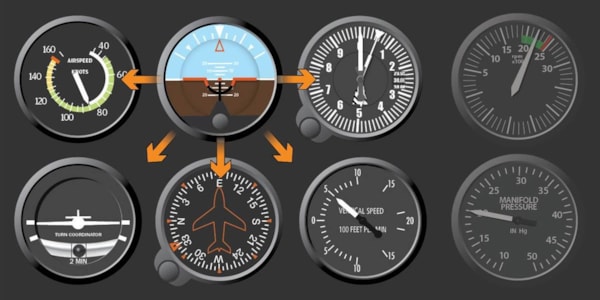Best cross-checking techniques to master your instrument scan

Photo from the AOPA
In reduced visibility conditions when the horizon is lost, pilots may lose their capability to rely on what they see outside of the cockpit which can cause vertigo, loss of control, and even lead to a sudden crash landing. For pilots to avoid spatial disorientation they must learn to rely on their instruments. Instrument flying expands the conditions under which a pilot may fly. Pilots with private certificates may only fly under visual flight rules (VFR) conditions. This is restrictive, especially in areas that experience frequent precipitation, clouds, and fog.
Throughout the flight, references must be made to the basic flight instruments in addition to the navigation and engine instruments. It can be helpful to group the instruments according to the information they provide. The instruments that provide pitch information are the attitude indicator, airspeed indicator, altimeter and vertical speed indicator. The instruments that provide bank information are the attitude indicator, heading indicator and turn coordinator. For power, the tachometer and manifold pressure gauges give an indication of the engine’s performance.
Depending on the phase of flight, certain instruments are considered either primary or secondary in importance. For pitch, the altimeter gives the best source of information in straight and level flight. For bank, the heading indicator is the best indication. The other instruments give secondary information that can be used for cross-checking, which means confirming that the plane is doing what you want it to do.
The pilot should always be scanning but in the case of a partial panel it becomes crucial that you do not miss the slightest onset of an unwanted bank, descent, or other disturbance. There’s a natural instinct to fixate on a single instrument, which can be disastrous with either a full or partial panel. For example, it is common to fixate on the heading indicator during a turn to a heading. When staring at the heading indicator you might fail to notice that you’ve lost altitude, or are beginning to turn. Making corrections early on helps prevent the need for bigger corrections later on. Here are some of the best techniques to try and practice for mastering the cross-check in your instrument scan.
Note* Since power + attitude = performance, the attitude indicator is arguably the most important instrument that pilots have available to them.
The linear scan
This type of scanning technique involves recognizing and establishing a “master instrument”. The “master instrument” as well as the scanning sequence will vary depending on the phase of flight you are in. For example, in the case of straight and level flight, we can establish the attitude indicator as the “master instrument” because it provides the pilot with a clear picture of the aircraft’s relative position to the Earth’s horizon. This scan will then employ an instrument scanning pattern that radiates out from, and always returns to, the attitude indicator.
The circular scan
Imagine a circular or oval-like pattern that sits over all six flight instruments. The linear music scan can be fatiguing, but it is mostly used when you are adjusting the airplane’s attitude and/or power. The circular scan is more relaxing and it allows you to make small corrections as you evaluate all six flight instruments. You can continue the circular scan pattern as long as the airplane is in stabilized, straight-and-level flight.
The inverted “V” scan
This scan provides you with nine pieces of information. The three that come from the airspeed indicator are the pitch attitude, bank attitude and bank angle. The VSI gives you two, which are the trend and rate of vertical movement. The remaining four come from the turn coordinator and are the trend, rate of turn, rate of roll and rudder coordination. This scanning technique may be used if an instrument failure is suspected because the three instruments scanned are typically driven by different systems. In many aircraft the airspeed indicator gyro is vacuum-driven whilst the gyro for the turn indicator is electrically driven. Meanwhile, the VSI uses a static system. As a result, a failure of any one of these systems would result in two out of the three instruments agreeing while the instrument driven by the failed system would show a discrepancy.
The “T” scan
This technique enables the pilot that is manually flying the airplane to concentrate primarily on the major performance indicator, the attitude indicator (or artificial horizon) and scan out and back to the secondary instruments. The secondary instruments include the airspeed indicator and altimeter and form a “T” across the instrument panel.
The music scan
Using a slow speech rate, you can say the following musical beat: “and one and two, and one and two, and one and two, and one and two…”. This is how fast your eyes should move between instruments. When you say “and,” glance at the attitude indicator; when you say “one,” glance over at the turn coordinator; and when you say “two,” look at the VSI. This helps to prevent over-fixation on one instrument by establishing a constant scanning rhythm.
RELATED STORY:
New FAA guidance updates aircraft approach category for instrument approach
An effective instrument scan is like reading a book or even this article. Rather than reading each individual letter you are scanning and interpreting the words and sentences as a whole. This is the same way that a proficient instrument pilot will read the panel as a whole, rather than each individual instrument in isolation.



Recent Comments